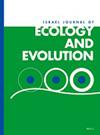Intercontinental-wide consequences of compromise-breaking adaptations: the case of desert rodents
IF 0.8
4区 环境科学与生态学
Q3 ECOLOGY
引用次数: 19
Abstract
Desert rodent assemblages from around the world provide convergent, but independent crucibles for testing theory and deducing general ecological principles. The heteromyid rodents of North America and the gerbils of the Middle East and their predators provide such an example. Both sets of rodents face predation from owls and vipers, but the North American species possess unique traits that may represent macroevolutionary breakthroughs: rattlesnakes have infra-red sensitive sensory pits, and heteromyids have cheek pouches. To test their significance, we brought together two gerbils (Middle East), two heteromyid rodents (a kangaroo rat and a pocket mouse; North America) in a common setting (a vivarium in the Negev Desert), and quantified the “opinions” of the rodents towards the North American sidewinder rattlesnake and the Middle Eastern Saharan horned viper and the foraging behavior of each in the face of these snake predators plus owl predators. Gerbils are fairly evenly matched in their anti-predator ab...破坏妥协适应的洲际后果:以沙漠啮齿动物为例
来自世界各地的沙漠啮齿动物群落为检验理论和推导一般生态原理提供了趋同但独立的检验标准。北美的异齿啮齿动物和中东的沙鼠及其捕食者就是这样一个例子。这两种啮齿类动物都面临着猫头鹰和毒蛇的捕食,但北美物种拥有独特的特征,可能代表着宏观进化的突破:响尾蛇有红外线敏感的感觉凹陷,异齿蛇有脸颊袋。为了检验它们的重要性,我们把两只沙鼠(中东)、两只异胚啮齿类动物(一只袋鼠鼠和一只口袋鼠;在一个共同的环境中(内盖夫沙漠的一个动物群落),并量化了啮齿动物对北美响尾蛇和中东撒哈拉角蝰的“意见”,以及它们在面对这些蛇掠食者和猫头鹰掠食者时的觅食行为。沙鼠在对抗捕食者的能力上不相上下。
本文章由计算机程序翻译,如有差异,请以英文原文为准。
求助全文
约1分钟内获得全文
求助全文
来源期刊

Israel Journal of Ecology & Evolution
环境科学-进化生物学
CiteScore
2.10
自引率
0.00%
发文量
7
审稿时长
>36 weeks
期刊介绍:
The Israel Journal of Ecology and Evolution includes high-quality original research and review papers that advance our knowledge and understanding of the function, diversity, abundance, distribution, and evolution of organisms. We give equal consideration to all submissions regardless of geography.
 求助内容:
求助内容: 应助结果提醒方式:
应助结果提醒方式:


